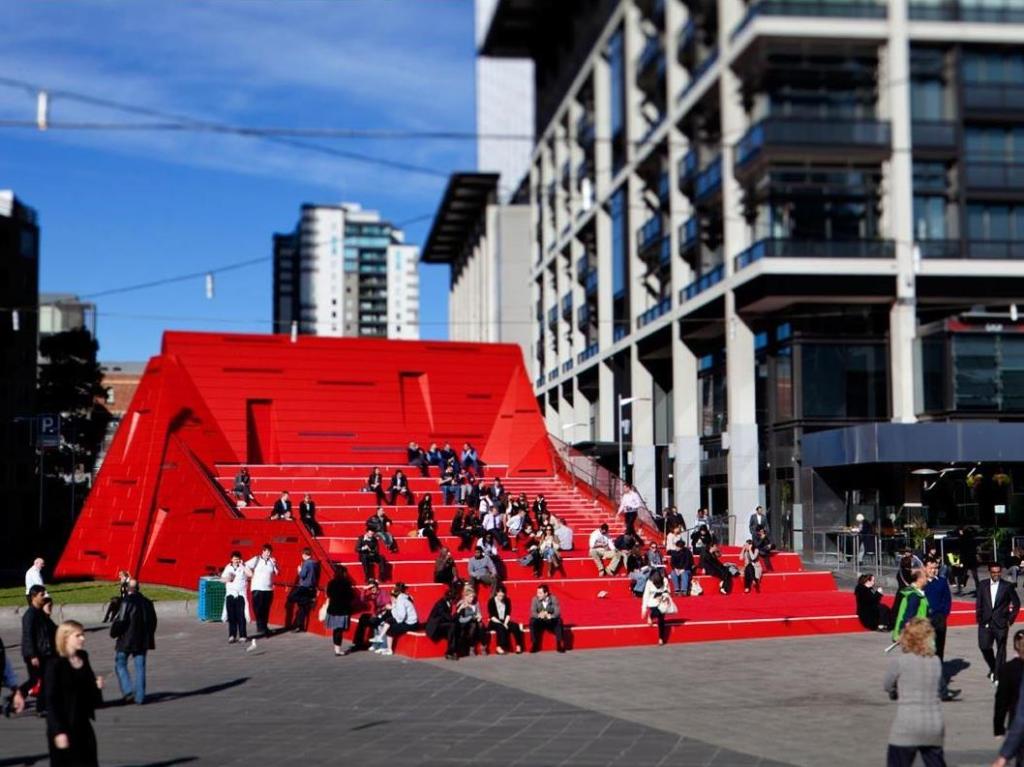Queensbridge Square City of Melbourne Design & Urban Environment. Photograph Andrew Curtis.
Melbourne has positioned itself at the forefront of Australian culture, as an emerging hub for design and architecture, and a rich history in the arts.
Along with accolades such as the world’s Most Livable City and awards in sustainable design, the current National Gallery of Victoria exhibition Melbourne Now demonstrates the innovation and beauty that can emerge through interdisciplinary projects.
These projects involve public institutions, urban designers, governments, creatives and the wider community investing in risky creative ventures to provide opportunities and conditions for collaborations to occur.
As the panel of Melbourne Conversation’s Talking about Art and Change (30 January), a key aspect in encouraging greater interdisciplinary practice is the facilitation of an ease of dialogue between Melbourne’s artists, designers and architects.
Ian McDougall, Founding Director of ARM Architecture, said that while architecture is widely seen as either a commercial or industrial pursuit, its ‘true core is in the arts’.
Rather than fulfilling a purely functional role, architecture should be seen as a creative practice. Its creative nature becomes increasingly recognised as a city assumes greater responsibility for fostering diversity in the arts, as has occurred in New York and more recently Detroit.
McDougall suggested local governments could provide more opportunities for young architects who are too commonly overlooked, or who miss out during the fee bidding process.
As Melbourne’s city continues to grow, there are many open outdoor spaces begging for urban planners to assert their presence and work with designers to create practical, sustainable and aesthetically pleasing environments. Local artists could be commissioned to create public artworks to revitalise these places.
Of course, the most obvious urban space demanding attention in Melbourne is Docklands, which this panel unanimously agreed holds much potential as a burgeoning hub for Melbourne’s artists.
The area’s volume of available indoor space was noted as holding rich potential for artists’ studios, yet the current rental structure demands a budget beyond the present scope of this sector.
As well as funding, there is the rapidly advancing issue of Melbourne becoming two cities with a growing divide between the well-served, culturally-rich inner-city and its suburban and outer-suburban counterparts.
These outer areas are becoming home to a growing artistic community who have been pushed out of the inner-city due to increasing rents and housing prices.
Visual artist Emily Floyd noted instances of artists creating initiatives in suburbs such as West Heidelberg and Caroline Springs. However, she said it is much harder to manage and sustain collaborative projects in these districts than it is in the inner-city.
While the creative industries see great potential with innovative housing typologies and arts ventures in greater Melbourne and regional areas, there is an overwhelming lack of infrastructure spending in these localities to support the arts.
Melbournians are keenly engaged in the city’s arts scene and more opportunities for public participation should be welcomed. As seen in events such as last year’s inaugural White Night. When invited, the city comes together to embrace the arts in all their diversity.
All levels of government need to support creative ventures and exploration in art, design and architecture through facilities, amenities, policies and funding. This, in combination with the generosity of Melbourne’s community, will see the city’s arts scene continue to prosper, as it rightly affirms its place as a global leader in contemporary art.





